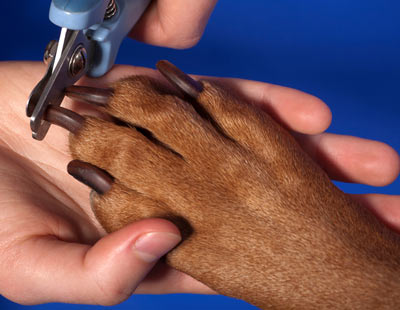Helpful Tips for Trimming Your Dog's Nails

Trimming a dog's nails can be an intimidating thing for a dog-owner to consider doing. Still, it needs to be done sometimes, or your dog will risk tearing or breaking claws, and they may do more damage to carpet, hardwood floors, or people.
Step-by-Step Instructions for Trimming Your Dog's Claws
Here are the steps to follow to trim your dog's nails:
- It can be helpful to wear your dog out a bit before trimming nails. Have a fun, romping play session first.
- Try trimming nails when your dog is a bit hungry. He'll be more interested in receiving treat rewards for cooperation if he hasn't just finished a meal.
-
It can be vastly easier to have a helper available. The helper can distract your dog with treats, gently restrain him to keep him from running off, and even hold each paw steady to keep him from yanking it away from you.
- Have your dog sit, and gently lift his paw. If you need to, push back any fur that's covering the nail.
- Using the appropriate nail trimmers for your dog's size, trim off the tip of your dog's nail. There is a blood vessel in each claw, so you should avoid hitting that if possible. If your dog's nails are white, you will see the pink part inside; don't trim past that. If your dog's nails are black, you probably won't be able to see the blood vessel. The best thing to do in that case is to simply trim off the very end of your dog's nails and do it once a week, so the nails don't grow too long. The blood supply grows out with the nail, so longer nails will need to be inched back by routine trimmings rather than chopped all the way back at once.
-
Don't panic if the nail bleeds. Remain at ease and speak calmly to your dog. You can use cornstarch, flour, or styptic powder pressed firmly into the end of the nail to stop the bleeding.
Be sure to reward your dog and make the experience a pleasant one for him. Don't punish him for not cooperating; simply go more slowly. You may only be able to do a nail or two at first if your dog is afraid or doesn't cooperate. Just do what you can, and try again the next day.
It's best if you can get your dog used to nail trims and general paw-handling as a puppy if you have him then. That will ensure that it's easy for you to trim his nails throughout his life.
Your groomer or veterinarian can also trim your dog's nails, and this might be a good option for a dog that is fearful or aggressive for nail trimmings.
You May Also Like These Articles:
How to Get Rid of Skunk Smell on a Dog
Dog Shaving: Helpful or Harmful?
Foxtails: A Summertime Hazard for Dogs
Dog Fleas: How to Look for Fleas on Your Dog
How to Cope with Canine Anxiety and Fear by Using Adaptil(TM) (Formerly called D.A.P)
Disclaimer: This website is not intended to replace professional consultation, diagnosis, or treatment by a licensed veterinarian. If you require any veterinary related advice, contact your veterinarian promptly. Information at DogHealth.com is exclusively of a general reference nature. Do not disregard veterinary advice or delay treatment as a result of accessing information at this site. Just Answer is an external service not affiliated with DogHealth.com.
Notice: Ask-a-Vet is an affiliated service for those who wish to speak with a veterinary professional about their pet's specific condition. Initially, a bot will ask questions to determine the general nature of your concern. Then, you will be transferred to a human. There is a charge for the service if you choose to connect to a veterinarian. Ask-a-Vet is not manned by the staff or owners of DogHealth.com, and the advice given should not delay or replace a visit to your veterinarian.



